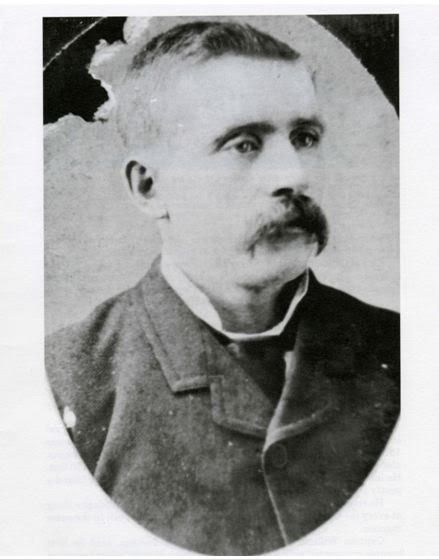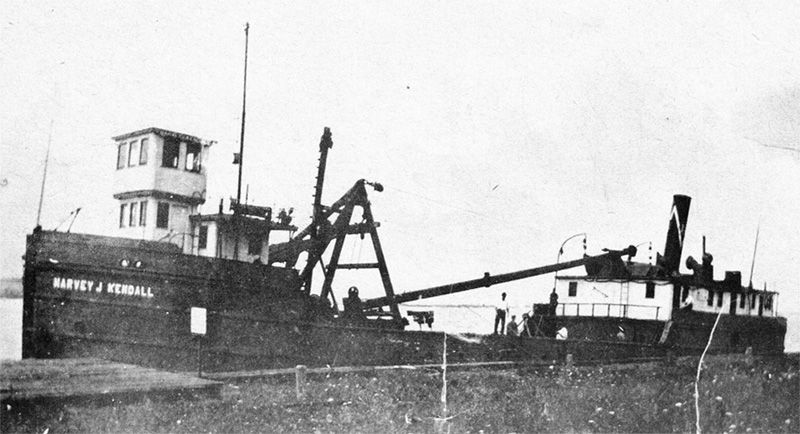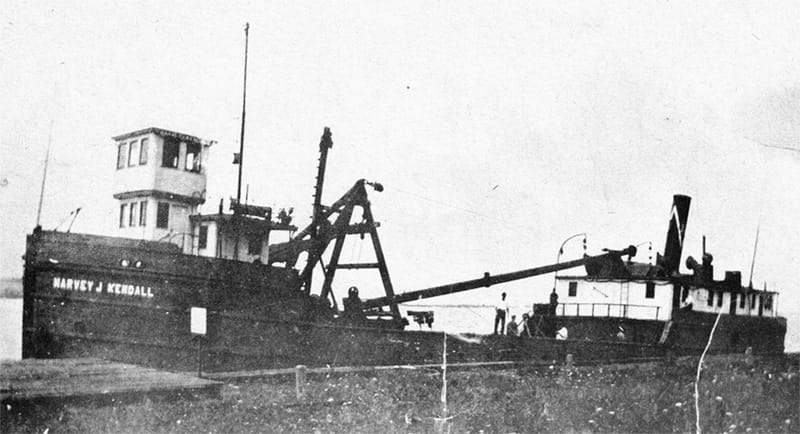Sinking of the Harvey J. Kendall, another Augustus Hinckley Story
by: Richard Palmer
The last freighter owned by Capt. Augustus R. Hinckley was the wooden steamer HARVEY J. KENDALL (U.S.96166), 141.7' x 30.9' x 9.2', 398 Gross, 264wt., Net wt., which was built at Marine City, Michigan, in 1892. The captain bought her from the George Hall Corporation of Ogdensburg in 1930 to replace the lost HINCKLEY. (Actually, the sale was probably in 1929 - Ed.) HARVEY J. KENDALL was a rather odd-looking boat and was nearing the end of her days when she was acquired, for her hull was badly deteriorated.
The following story of the last days of the KENDALL was related in 1973 by the captain's nephew, Theodore Hinckley, who sailed aboard her on her last trip, during which she sank in the Cardinal Canal.

"This is what I remember of my trip on HARVEY J. KENDALL under Capt. Gus Hinckley. This was the last civilian contract he obtained to pick up Coast Guard buoys; the U.S.C.G. took over this duty the following year. Uncle Gus stopped at the Cape (Vincent) about the middle of December, 1930. Some of his crew had quit and gone home, and he lacked a couple of deckhands and a coal passer. So George Cody, Earl Snyder and myself hired on to go down River with him and pick up buoys as far as Waddington, the last in American waters.
"Cody was fireman, Snyder and I deckhands.
The old KENDALL had a high steeple compressed steam boiler which had a lot of leaks round about, but still worked. The engineer was Woods, of Alexandria Bay. He was a big, fat guy, took about a 52" waist. Cody's relief coal passer was called 'Pipe Boiler' Paddy, from Oswego, built like Cody, tall and lean, waist about 32"; he wore a pair of overalls that the engineer had discarded, but wrapped around once again. We all got a bang out of seeing him with that outfit on. He was almost as dirty with coal dust as were the overalls.
"The hoist man was Jimmie Cree, an Indian from Morristown, a hard worker and a hard drinker, too. The mate was from Alex(andria) Bay, but I forget his name. Aunt Lydia was the captain's wife and also served as the cook. He couldn't find any other cook for the trip and was cutting the expenses as much as he could because he had bid too low on the contract.
"Uncle Gus had tied up at the depot dock in Cape Vincent and, about December 15, we shoved off and sailed to pick up the buoys. Earl Snyder could not go, as his father, J.P. Snyder, had refused him permission, so I was deckhand and coal passer combined. We picked up buoys all the way down River and unloaded them at Ogdensburg. Then we got buoys from the harbour there and went down River to Waddington and got the last of them. It had turned very cold the night we left the 'Burg (Ogdensburg), and it was making ice in the canals and bays, so we ran the River and, with the current, made good time to retrieve the last buoys at Waddington.

"My duties were to work on deck while we were taking buoys aboard and to pass coal onto the fireroom floor while underway. The meals were nothing to talk about with any praise, but Auntie did the best she could. A roast beef went a long way; first a roast, then hash, and finally soup. Everything else was the same; a ham was served about four different ways and the bone ended up in pea soup.
"I don't think anybody undressed fully at night. I know that I didn't. Our quarters were too cold but that didn't freeze out the bugs. They were in full power. The blankets and bunks were loaded with them. I left my socks and underwear on, so I only got bitten around my wrists, ankles and neck. Little red spots showed up every morning, but I was so tired at night that I slept anyway.
"We had seven spar buoys, three nun and two big flasher buoys aboard when we finished up at Waddington and started back for the 'Burg about the middle of the last day. Uncle Gus figured that we could make it back by working the eddies along the shore out of the direct current. He was right, except for one thing. Somehow the draft damper in the stack had become loose and the outside balance arm showed the draft wide open whereas it was actually only half-opened. The set bolts had slipped, as we later discovered.
"We knew it was making ice in the canal and, as KENDALL was built of wood, we didn't want to chance it. So we started up River bucking the current. It seemed to go pretty well; I was passing coal and could look out the ash-chute hole and get a sighting on shore. Engineer Woods kept at Cody, the fireman, for more steam and Cody kept after me for more coal. Finally, I told Cody to get a sight on the shore; we were just holding our own and that was all. The captain was whistling for more steam but we just could not make it.
He swung in nearer to shore to catch an eddy and hit bottom just like three steps (bump, bump, bump) and there we stayed. We tried to reverse and then tried everything else, but to no avail. Capt. Gus had the idea to put the hatch cover across the jolly boat and have myself and Jim Cree take it out in the River astern to act as a keg anchor, but this did not pan out because both the mate and I rebelled. If the lifeboat had tipped over when we dumped the anchor, we would both have been goners, for the water was ice-cold. So we had a farmer call Kingston, Ontario, to contact the tug SALVAGE QUEEN to come and get us off.
"Next morning, SALVAGE QUEEN arrived and dropped anchor above the KENDALL, then paid out cable until we got it from her stern. Then she took up on her forward winch until she was half-way to the upper anchor. She started both winches and, using herself as one big winch, pulled us off the rocks. All the power the QUEEN had was in her winches; her engine was not very powerful and she couldn't buck the current, so we both dropped back and entered the canal below Cardinal. We tied up there to inspect the hull, but no bad leak showed where we had been on the rocks. Uncle Gus said that it was ledges and no boulders, so just the keel and forefoot were hit, and the hull was not damaged.
"The two captains talked things over and decided that SALVAGE QUEEN would lead, the KENDALL to follow, as there was about three inches of ice in the canal. Meanwhile, Uncle Gus had Woods and Cody check the damper in the stack and they found that the set bolts had loosened. It was adjusted and okayed. SALVAGE QUEEN started out but, even though she had a steel hull, she could not make it as the ice was too thick. New ice was tough, so she called Kingston for SALVAGE PRINCE, for she had lots of propeller power and an icebreaking bow. Unfortunately, she couldn't get there until the next day.
"Gus didn't want to wait and said we'd try it, as KENDALL had power enough but was only ironed (sheathed) part-way on the bow, which he figured was enough. So we started out of the lock for a ways but then new ice started. We'd make 200 or 300 feet, then back and ram it again. The poor old ship took a beating when we hit the ice but she would do well, her deck humping up and down like in an ocean roll, then stop, back, and hit again. About a quarter-mile outside of Cardinal, Cody called me to pass more coal. I stepped off the fireroom floor into about four inches of ice water in the bunker.
"I hollered to Cody 'better get me a pair of rubber boots as there's water in the bunker'. The engineer and Cody came in with a lantern and you should have seen the engineer's face when he showed the light in the bunker. The coal bunkers were in the stern near the fantail and, every time we backed, the stern would hit hard in the ice, and that had started the seams leaking. It was spouting 'pretty good' into the bunkers. The engineer notified Uncle Gus, who stopped her and held her into the ice.
"But nothing could be seen above water. The bilge had already been sounded and the water was gaining at a good rate even though we had two pumps going. Gus decided that, if we could get to Cardinal, we could stop and lay up, as it was getting dark. We made four more lunges at the ice and came to Dodge's coal dock outside Cardinal. Gus called for me and I jumped onto the dock; it was icy but I hung on. He whistled to go ahead and I thought that he had left me, but it was just to break ice so he could get closer to the dock. Finally, he backed up and I took a line and made fast fore and aft.
"By this time, the old KENDALL was making water pretty fast and it took a lot of coal to keep up steam. We had a four-inch bilge pump and two two-inch steam siphons going full blast, as well as the generator, and still we needed steam for the engine. The only way I could get coal on the fireroom floor was to rake it out of the bunker with the big fire rake. After we tied up, the water was sounded for depth in the canal and we found that if she did sink, the upper works and the top of the spray rail between fore and aft would be out of water, even though the keel was on the bottom.
"Gus had the engine shut down and he told Woods to keep the pumps going full. He said that he would be back inside of an hour, and away he went into the night. It was really dark by this time. I got a pile of coal ready for Cody and he said to me 'It won't be long now'. But there were still rats in the galley and we wouldn't go under as we were tied to the dock. I couldn't help but laugh, even though it was bad luck for poor old Uncle Gus.
"The water started to creep up on the fireroom floor. Woods told Cody to pull the fire, as the ice water would blow up the boiler if it was hot. So Cody dumped the fire and we climbed topside. We all got our gear together and were standing by as the pumps and generator started slowing down for lack of steam. Then we heard a team of horses on the run coming down the road. People were yelling. Into the coal shed and onto the dock came Uncle Gus and a farmer riding a wagon of horse and cow manure mixed with straw, this just as the lights dimmed and the steam siphons quit. It was kind of gruesome, the KENDALL groaning and settling. The only light came from the flashing tops of the buoys which stuck out of the hatches. They bumped the deck as the old boat went down, but stayed in the hold.
Of course, Uncle Gus was mad as a hornet but Woods told him that he was afraid of blowing the boiler if water hit the hot grates. The engineer knew what to do, as he had his bag packed in ten minutes and came off the ship all dressed up. He had been ready long before.
"Maybe I had better explain the load of straw and manure that Uncle Gus got. In the old days of wooden vessels, if a bad leak developed in the seams under water, the caulking usually had become loose or was pushed through. If the boat wasn't in too much current or under way, sometimes wet sawdust or manure with lots of straw mixed in would, when dropped over the side, settle along the hull and be sucked into the leaking seams. This would lessen or stop a leak so that temporary repairs could be made. But I don't think that forty loads would have saved the old KENDALL.
"Uncle Gus had me swing down to the galley wall through a hole topside by the top of the boiler to retrieve a clock. We took hand lights and went forward and got Aunt Lydia out of the captain's cabin where she had been all this time. We went on the dock, into the coal shed, where we called Cardinal and had cars come to get us. Uncle Gus did not have much cash on him, but borrowed some from Mr. Dodge who owned the coal dock, and he gave us each $20 on what he owed us. The spar and nun buoys were floating on deck, held there by the fareboard which was just out of the water, and the lights were flashing on the big gas buoys. That's how we left the HARVEY J. KENDALL.
"The crew took a bus to Prescott and then Ogdensburg. We had to wait at the 'Burg for a train to Watertown... Cody and I left Watertown for Cape Vincent and the others went home. When I got home, I told Laulie, my wife, that I had better strip off my clothes on the outside porch and, while I did that, to start the tub running, as I badly needed a hot bath. It was cold that day but we had to fumigate my clothes and other gear just the same. I got home three days before Christmas.
"The only lives lost in the sinking of the KENDALL were a lot of bedbugs."
The Lighthouse Service, which had charge of all navigation aids at that time, got the buoys and took them to Ogdensburg. The following spring, Uncle Gus, Jim Cree and a couple of other men sealed off the leaks with canvas and lumber and pumped the KENDALL until they raised her so that she could be beached and repaired.
She was brought to the breakwall at Cape Vincent but the steamboat hull and boiler inspectors of Oswego would not give Uncle Gus clearance to sail the lake and would only permit operation on the River.
"At the same time, engineer Woods put a lien against her for past wages, so Gus gave up. She was stripped of most of the removable items of any value, and Wilfred Dodge towed her to Button Bay, where he ran her up on the south corner of the marsh. That winter and the following spring (1932), the KENDALL drifted out and down the bay. She got as far as Perch Cove, out from Home's cottage, and sank there. Her remains still lie there in about fifteen feet of water."
by Richard Palmer
Richard F. Palmer is a retired newspaper editor, and reporter, and was well known for his weekly historical columns for the “Oswego Palladium-Times” called "On the Waterfront." His first article for TI Life was written in January 2015 and since then, he has written a half-a-dozen others. He is a voracious researcher and TI Life readers benefit from his interesting findings. Click here to see Richard Palmer’s TI Life Articles before the new format began, (February 2019). And Click here to see the first in this series of three article about Augustus Hinckley.
[Originally published in The Scanner, the monthly news bulletin of the Toronto Marine Historical Society.]






Please click here if you are unable to post your comment.